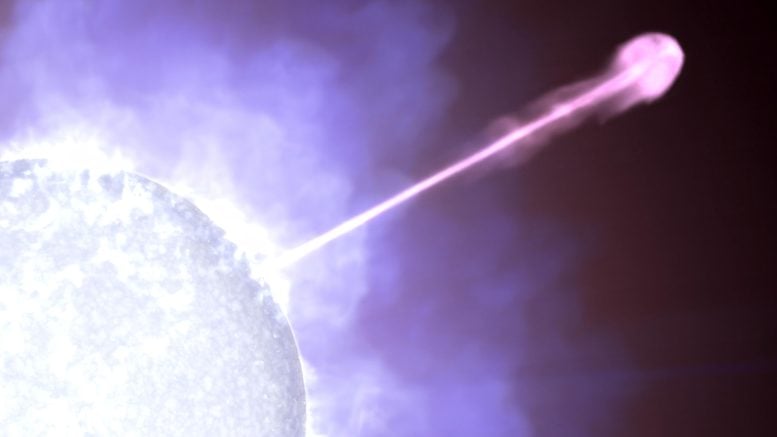
In this artist’s impression, a jet of particles traveling at nearly the speed of light emerges from a massive star. The star’s core has run out of fuel and collapsed into a black hole. Some of the material swirling toward the black hole has been redirected into two jets shooting in opposite directions. A burst of gamma rays is seen when one of these jets points directly toward Earth. Credit: NASA’s Goddard Space Flight Center Conceptual Image Lab
Use of data from
” data-gt-translate-attributes=”({“attribute”:”data-cmtooltip”, “format”:”html”})” tabindex=”0″ role=”link”>NASAUsing the Fermi Gamma-ray Space Telescope, researchers have discovered a unique energy spike following the brightest gamma-ray burst ever observed, suggesting the annihilation of electrons and positrons. This discovery provides new insights into the behavior of cosmic jets and the extreme conditions that follow such bursts.
In October 2022, astronomers were stunned by what was quickly dubbed the BOAT, the brightest gamma-ray burst (GRB) ever. Now, an international science team reports that data from NASA’s Fermi Gamma-ray Space Telescope reveals a feature never seen before.
Unprecedented spectral feature identified
“A few minutes after the BOAT flare, the Fermi gamma-ray burst monitor recorded an unusual energy spike that caught our attention,” said Maria Edvige Ravasio, principal investigator at Radboud University Nijmegen, the Netherlands, and affiliated with the Brera Observatory, part of INAF (the Italian National Institute of Astrophysics) in Merate, Italy. “When I first saw this signal, I got goosebumps. Our analysis since then shows that this is the first high-confidence emission line ever observed in 50 years of studying GRBs.”
An article about the discovery appears in the July 26 issue of the journal Science.

The Fermi Gamma-ray Space Telescope observes the cosmos using the most energetic form of light, providing an important window into the universe’s most extreme phenomena, from gamma-ray bursts and black hole jets to pulsars, supernova remnants and the origin of cosmic rays. Credit: © Daniëlle Futselaar/MPIfR (artsource.nl)
When matter interacts with light, energy can be absorbed and re-emitted in characteristic ways. These interactions can brighten or dampen certain colors (or energies), producing key features that are visible when light is scattered, like a rainbow, across a spectrum. These features can reveal a wealth of information, such as the chemical elements involved in the interaction. At higher energies, spectral features can reveal specific particle processes, such as the annihilation of matter and antimatter to produce gamma rays.
“Some previous studies have already reported possible signs of absorption and emission in other gamma-ray bursts, but a closer look revealed that these could all be just statistical fluctuations. What we see in the BOAT is different,” said study co-author Om Sharan Salafia of the INAF-Brera observatory in Milan, Italy. “We determined that the probability that this feature is just a noise fluctuation is less than a one in half a billion chance.”
The nature and impact of gamma-ray bursts
GRBs are the most powerful explosions in the cosmos and emit large amounts of gamma rays, the most energetic form of light. The most common type occurs when the core of a massive star exhausts its fuel, collapses, and forms a rapidly rotating star.
” data-gt-translate-attributes=”({“attribute”:”data-cmtooltip”, “format”:”html”})” tabindex=”0″ role=”link”>black holeMatter falling into the black hole fuels jets of oppositely directed particles that travel through the star’s outer layers at nearly the speed of light. We detect gamma-ray bursts when one of these jets points almost directly toward Earth.
BOAT, officially known as GRB 221009A, erupted on October 9, 2022, and quickly overwhelmed most orbiting gamma-ray detectors, including those on Fermi. This prevented them from measuring the most intense part of the explosion. The reconstructed observations, combined with statistical arguments, suggest that BOAT, if part of the same population as previously detected GRBs, was likely the brightest explosion to appear in Earth’s sky in 10,000 years.
The brightest gamma-ray burst ever recorded has given scientists a new high-energy feature to study. Find out what NASA’s Fermi mission observed and what this feature can tell us about the burst’s light-speed jets. Credit: NASA’s Goddard Space Flight Center
Insights into interactions between cosmic particles
The suspected emission line appears about 5 minutes after the burst was detected and well after it had faded enough to end saturation effects for Fermi. The line persisted for at least 40 seconds, and the emission reached a peak energy of about 12 MeV (million electron volts). For comparison, the energy of visible light ranges from 2 to 3 electron volts.
So what produced this spectral feature? The team thinks the most likely source is the annihilation of electrons and their antimatter counterparts, positrons.
“When an electron and a positron collide, they annihilate, producing a pair of gamma rays with an energy of 0.511 MeV,” said study co-author Gor Oganesyan of the Gran Sasso Institute of Science and the Gran Sasso National Laboratory in L’Aquila, Italy. “Since we are observing the jet, where matter is moving at close to the speed of light, this emission undergoes a significant blueshift and is pushed to much higher energies.”
Future directions for research and collaboration
If this interpretation is correct, to produce an emission line peaking at 12 MeV, the annihilating particles would have had to be moving toward us at about 99.9% of the speed of light.
“After decades of studying these incredible cosmic explosions, we still don’t understand the details of how these jets work,” said Elizabeth Hays, a Fermi project scientist at NASA’s Goddard Space Flight Center in Greenbelt, Maryland. “Finding clues like this remarkable emission line will help scientists study this extreme environment more deeply.”
The Fermi Gamma-ray Space Telescope is an astrophysics and particle physics partnership managed by Goddard. Fermi was developed in collaboration with the U.S. Department of Energy, with significant contributions from academic institutions and partners in France, Germany, Italy, Japan, Sweden, and the United States.